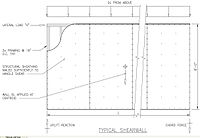
Photo from wikipedia
Abstract This paper investigates the relationship between out-of-plane stiffness and in-plane stiffness in the frame shear wall with edge restraint member for achieving the full in-plane performance. Three experimental specimens… Click to show full abstract
Abstract This paper investigates the relationship between out-of-plane stiffness and in-plane stiffness in the frame shear wall with edge restraint member for achieving the full in-plane performance. Three experimental specimens were carried out under the cycle loading for examining the seismic behavior of corrugated steel plate shear wall. According to the failure mode of the tested specimens, the details of horizontal corrugated steel plate shear wall were chosen and used to establish simulation model for researching stiffness matching relation. Compared with experimental results, the validity of simulation had been verified. Based on the study of models with different parameters, the new index was proposed for assessing the matching relationship between out-of-plane and in-plane stiffness, and the index was named as in-plane and out-of-plane stiffness ratio. The research results exhibited, when the ratio was more than 4.5%, the structure would realize full lateral response under the seismic action. Besides, the stiffness simplified calculation method and matching design step were proposed, where the stiffness values using theory calculation method were nearly same with the simulation results. With considering safety, economy and initial imperfection of structure, the ratio was slightly enlarged to 4.7%. Finally, an example was given for illustrating the matching design method which could provide the reference in practical engineering.
Journal Title: Structures
Year Published: 2021
Link to full text (if available)
Share on Social Media: Sign Up to like & get
recommendations!